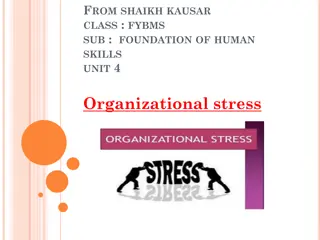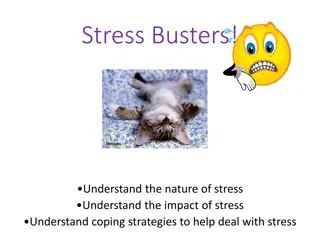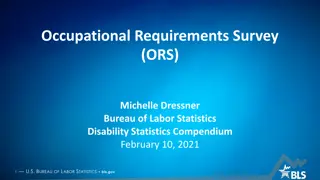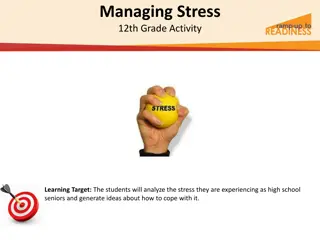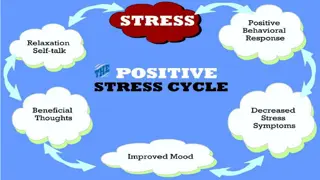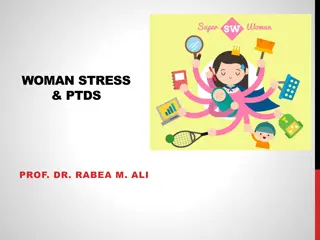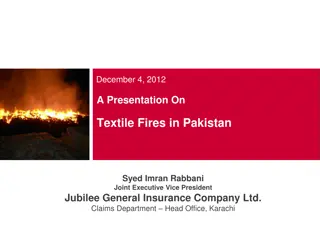Occupational Stress Among Textile Workers: Coping Strategies and Gender Differences
The textile sector in Turkey employs a large number of workers, predominantly women, who face high levels of occupational stress due to poor working conditions, low pay, and demanding workloads. This stress results from a mismatch between job demands and employee capabilities, leading to negative impacts on productivity and mental health. Women are particularly vulnerable to stress, with coping strategies such as yoga, meditation, and spending time with loved ones recommended to manage stress effectively.
Download Presentation

Please find below an Image/Link to download the presentation.
The content on the website is provided AS IS for your information and personal use only. It may not be sold, licensed, or shared on other websites without obtaining consent from the author. Download presentation by click this link. If you encounter any issues during the download, it is possible that the publisher has removed the file from their server.
E N D
Presentation Transcript
Textile workers: Occupational Stress, coping strategies and related factors Koseoglu Ornek, O.1 and Esin, M.N., 20152 1 Istanbul Bilgi University, 2 Istanbul University Presenter Ozlem Koseoglu Ornek Phd student- Lecturer E mail: ozlem.koseoglu@bilgi.edu.tr Istanbul-2015
2 Textile workers and Occupational Stress Textile business sector takes very significant share in working area in Turkey. There are thousands workers in this area. Generally, they work long time in unhealthy and unsafety conditions, extreme workload and also get less paid. The most of them are women and have low-socieconomic conditions which make them vulnerable. So, occupational stress is unavoidable due to contemproray work environment which is defined in many different words in the related literature. Such as job stress, stres at workplace.
Textile workers and Occupational Stress 3 Occupational stress; when demand s of the occupation is not compatible with the skills, knowledge and capability of the employee , this would overwhelm the coping mechanism this employee and occupational stress would develop in response to this (Akintayo, 2012; Peterson and Wilson, 2002). These responses would inevitably vary for each individual. However, employee who works in such a conditions like Textile sectors have more risky to develop stress.
4 Moreover, the effect of the stress varies between genders too, placing females in a more disadvantaged and vulnerable category when compared to their male counterparts. Research regarding effects of the stress on different genders revealed that woman are twice more likely to develop symptoms of stress than man. (Bilsker, Gilbert,Myete and Patterson, 2005).
5 Coping Strategies Coping mechanism with stress is different to person to person. It is much easier to coping with short time stress and it even contribute one s motivation compare to long time stress. Long time stress caused impairment of the productivity and performance of the employees as well as mental health problems such as depression (Wada et al., (2013)
Coping Strategies 6 The most important thing is to choose and practice a suitable coping strategies one s personalitiy and conditions. These are yoga, meditation, deep breathing exercises, relaxing exercises, enjoying time with friend and family, walking, and spending time for hobbies...
7 Occupational Stress Symptoms Generally observed physical symptoms are high blood pressure, high pulse, cheyne stokes respiration, decrease of immuglobulin IgA, increase of secretion of kortisol hormone, headache, stomachache, heart diseases, obesity, sleep disturbances and tense of muscles. Mental health symptoms involve irritability, tension, aggressive behaviours, lack of concentration, depression, perception disorder and obliviousness. Development of such symptoms of physical and mental ill health decreases the job quality, absenteeism, productivity, motivation, and threat workers health and safety (Houtman, Jettinghoff and Cedillo, 2007)
8 Some common factors of Occupational stressor These are changable work to work but these are the most commons according related literature. Such as; Excessive workloads Low salaries Conflicting demands Unclear rolles definitions Lack of social support or little support from colleques or supervisors Little contol over job process Poor work organization Few oppurtinities for advancement (American Pschological Association, 2015)
9 As a result of these conditions and outcomes, health protection, prevention and also promotion programs should be organized and implemented at the workplace. Occupational health nurses as a member of occupational team can take part easily and effectively in these programs. Accordingly, there was a necessity of such a research as define health problems and to be used as a guide for health promotion programs.
10 Research title: Textile workers: Occupational Stress, coping strategies and related factors The aim of this research study has been to examine occupational stress, coping strategies with stressors and relevant factors in textile workers. Method: It is a descriptive and cross sectional design. The data was collected from textile factories by using; 1. The Descriptive Characteristics of the worker s Assessment Form, 2. The Brief Job Stress Questionnaire (BJSQ) which was developed by Shimomitsu and et all, (2000) in Japan. 3. The Brief Scales for Coping Profiles (BSCP) that was developed by Kageyama, Kobayashi, Kawashima and Kanamaru, (2004).
Measurements 11 1. The Descriptive Characteristics of the worker s Assessment Form It was formed by the researcher according to related literature. It is comprised of 24 questions such as age, gender, mariage status, occupation, working time, economic situation, chronic and acut disease, sleep patterns, salary, education situation...) and, 2 questions about evaluation of work performance which were cited from related research by World Health Organization (Kessler et all., 2004; Kessler et all, 2003).
12 2. The Brief Job Stress Questionnaire (BJSQ) It was developed by Shimomitsu and et all, (2000) in Japan. It is consist of 57 items and graded on 4 point-scale. It has 4 subscales which are; Physical symptoms Psychological symptoms) and Job stress Social support
13 2. The Brief Job Stress Questionnaire (BJSQ) It has been translated and adapted for use in Turkish by Koseoglu Ornek and Esin, 2015. The both measurement have been found to have reliability and validity values. The Cronbach alphas score of The BJSQ was 0.74. According to factor analysis, the item total correlation coefficients ranges from 0.45 to 0.77.
14 3. The Brief Scales for Coping Profiles (BSCP) It was developed by Kageyama, Kobayashi, Kawashima and Kanamaru, (2004). It is comprised of 18 questionsand graded on 4 point-scale. It has 6 subscales which are; 1. Active solution 2. Seeking help for solution 3. Changing mood 4. Changing a point of view 5. Emotional expression involving others 6. Avoidance and suppression
15 3. The Brief Scales for Coping Profiles (BSCP) It has been translated and adapted for use in Turkish by Koseoglu Ornek and Esin, 2015. The both measurement have been found to have reliability and validity values. The Cronbach alphas score of the BSCP was 0.72. According to factor analysis, the item total correlation coefficients ranges from 0.48 to 0.73.
16 Results- Demographic caharecteristics The research samples were consisting of 668 textile workers. More than 53% of the workers were women. The mean age of all subjects was 33,2 9,9 years. Almost 49% of the workers had graduated from just primary school. The mean working hours per week was 62 5,9.
17 Almost 8% of the workers have worked without formal compulsory insurance payment by the employer. 69% of the workers defined their economic conditions as good . Almost 77% of the workers defined their health conditions as good More than 80% of them earn 270-500 USD dollars. Almost 40% of the workers gave 10 out of 10 point, 17.7% of them gave 8/10 to their general work performance
18 Results- the Brief Job Stress Questionnairee The score of the BJSQ was 113,9 20,3 (median:112), its subscales; The physical symptoms score was 15.3 12,9 (median:14), The psychological symptoms was 24,8 7,3(median:24) and The job stress was 54,2 9,24 (median:53). The social support was 17,7 4,9 (median:17) The scores above the median indicating job stress.
19 Results- Coping Strategies The scores of the BSCP was 53,8 8,3 (median:54), The scores from its 2 subscales which were higher than median; Changing a point of view 8,2 2,37 (median:8) and Seeking help for solution 2,9 1,1 (median: 2)
20 Results- Coping Strategies Theother scores from its some subscales which were lower than median; Emotional expression involving others 4,8 1,6 (median:5) Avoidance and suppression 4,6 1,6 (median:5) The scores above the median indicating unsuccessful coping methods.
21 Results- related Factors It was found significant an association between the workers gender and physical symptoms(p 0.05). It was shown that psychological symptoms and job stress level has ranged according to their economical situation (respectively; H=18,512 df= 3 p=0,000, H=7,954 df=3 p 0,05).
22 Results- related Factors It was found negative correlation between job stress level and the workers sleep quality and also general working performance (respectively;Spearman s q=-0,091, p=0,000:Spearman s q= -0,126, p=0,001). However, it was found positive correlation between psychological symptoms and the working hours peer week (Spearman s q= 0,082, p=0,05).
Conclusion 23 The job stress s level of the workers were found high and the coping profiles were found insufficient. Ultimately, these findings can be used as guidelines for the prevention of health problems in textile workers.
References 24 Akintayo, D. I., 2012. Occupational stress, psychological well-being and workers behaviour in manufacturing industruies in South-west Nigeria. Research Journal in Organizational Psychology & Educational Studies, 1:5;289-294 American Pschological Association, 2015. Internet access; http://www.apa.org/helpcenter/work-stress.aspx, retrieved at 17.08.2015. Bilsker, Gilbert,Myete ve Patterson, 2005. Depression & Work Function: Bridging the gap between mental health care & the workplace. Retrieved at :15 April 2015 http://www.sfu.ca/content/dam/sfu/carmha/resources/depression-work-function-bridging-the-gap-between/Work- Depression.pdf Houtman, I., Jettinghoff, K., ve Cedillo, L., 2007. Raising Awareness of Stress at Work in Developing Countries . Retrieved at: 20 May 2015, http://www.who.int/occupational_health/publications/raisingawarenessofstress.pdf?ua=1 Kageyama, T., Kobayashi, T., Kawashima, M., & Kanamaru, Y. (2004). [Development of the Brief Scales for Coping Profile (BSCP) for workers: basic information about its reliability and validity]. Sangyo eiseigaku zasshi= Journal of occupational health, 46(4), 103-114. Peterson, M., ve Wilson, J.F., 2002. The culture-Work-Health Model and Work stress. Am J Health Behav, 26(1):16-24 Shimomitsu T, Haratani T, Nakamura K, Kawakami N, Hayashi T, Hiro H, Arai M, Miyazaki S, Furuki K, Ohya Y, and Odagiri Y., 2000. The final development of the Brief Job Stress Questionnaire mainly used for assessment of the individuals. In: Kato M, ed. Research report of the Grant for the Prevention of Work Related Disease Sponsored by The Ministry of Labour: The 1999 Report, 126-137. Tokyo, Japan












